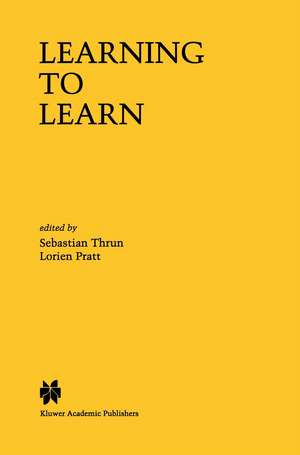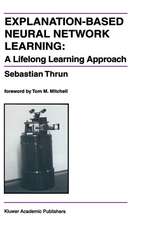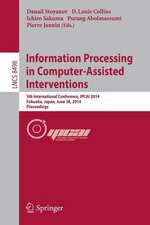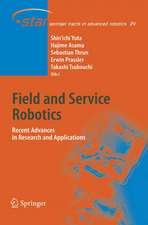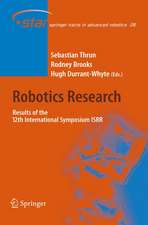Learning to Learn
Editat de Sebastian Thrun, Lorien Pratten Limba Engleză Hardback – 31 oct 1997
Learning to Learn is an exciting new research direction within machine learning. Similar to traditional machine-learning algorithms, the methods described in Learning to Learn induce general functions from experience. However, the book investigates algorithms that can change the way they generalize, i.e., practice the task of learning itself, and improve on it.
To illustrate the utility of learning to learn, it is worthwhile comparing machine learning with human learning. Humans encounter a continual stream of learning tasks. They do not just learn concepts or motor skills, they also learn bias, i.e., they learn how to generalize. As a result, humans are often able to generalize correctly from extremely few examples - often just a single example suffices to teach us a new thing.
A deeper understanding of computer programs that improve their ability to learn can have a large practical impact on the field of machine learning and beyond. In recent years, the field has made significant progress towards a theory of learning to learn along with practical new algorithms, some of which led to impressive results in real-world applications.
Learning to Learn provides a survey of some of the most exciting new research approaches, written by leading researchers in the field. Its objective is to investigate the utility and feasibility of computer programs that can learn how to learn, both from a practical and a theoretical point of view.
| Toate formatele și edițiile | Preț | Express |
|---|---|---|
| Paperback (1) | 1447.68 lei 6-8 săpt. | |
| Springer Us – 4 oct 2012 | 1447.68 lei 6-8 săpt. | |
| Hardback (1) | 1483.21 lei 6-8 săpt. | |
| Springer Us – 31 oct 1997 | 1483.21 lei 6-8 săpt. |
Preț: 1483.21 lei
Preț vechi: 1854.01 lei
-20% Nou
Puncte Express: 2225
Preț estimativ în valută:
283.85€ • 295.25$ • 234.33£
283.85€ • 295.25$ • 234.33£
Carte tipărită la comandă
Livrare economică 14-28 aprilie
Preluare comenzi: 021 569.72.76
Specificații
ISBN-13: 9780792380474
ISBN-10: 0792380479
Pagini: 354
Ilustrații: VIII, 354 p.
Dimensiuni: 155 x 235 x 27 mm
Greutate: 1.54 kg
Ediția:1998
Editura: Springer Us
Colecția Springer
Locul publicării:New York, NY, United States
ISBN-10: 0792380479
Pagini: 354
Ilustrații: VIII, 354 p.
Dimensiuni: 155 x 235 x 27 mm
Greutate: 1.54 kg
Ediția:1998
Editura: Springer Us
Colecția Springer
Locul publicării:New York, NY, United States
Public țintă
ResearchDescriere
Over the past three decades or so, research on machine learning and data mining has led to a wide variety of algorithms that learn general functions from experience. As machine learning is maturing, it has begun to make the successful transition from academic research to various practical applications. Generic techniques such as decision trees and artificial neural networks, for example, are now being used in various commercial and industrial applications.
Learning to Learn is an exciting new research direction within machine learning. Similar to traditional machine-learning algorithms, the methods described in Learning to Learn induce general functions from experience. However, the book investigates algorithms that can change the way they generalize, i.e., practice the task of learning itself, and improve on it.
To illustrate the utility of learning to learn, it is worthwhile comparing machine learning with human learning. Humans encounter a continual stream of learning tasks. They do not just learn concepts or motor skills, they also learn bias, i.e., they learn how to generalize. As a result, humans are often able to generalize correctly from extremely few examples - often just a single example suffices to teach us a new thing.
A deeper understanding of computer programs that improve their ability to learn can have a large practical impact on the field of machine learning and beyond. In recent years, the field has made significant progress towards a theory of learning to learn along with practical new algorithms, some of which led to impressive results in real-world applications.
Learning to Learn provides a survey of some of the most exciting new research approaches, written by leading researchers in the field. Its objective is to investigate the utility and feasibility of computer programs that can learn how to learn, both from a practical and a theoretical point of view.
Learning to Learn is an exciting new research direction within machine learning. Similar to traditional machine-learning algorithms, the methods described in Learning to Learn induce general functions from experience. However, the book investigates algorithms that can change the way they generalize, i.e., practice the task of learning itself, and improve on it.
To illustrate the utility of learning to learn, it is worthwhile comparing machine learning with human learning. Humans encounter a continual stream of learning tasks. They do not just learn concepts or motor skills, they also learn bias, i.e., they learn how to generalize. As a result, humans are often able to generalize correctly from extremely few examples - often just a single example suffices to teach us a new thing.
A deeper understanding of computer programs that improve their ability to learn can have a large practical impact on the field of machine learning and beyond. In recent years, the field has made significant progress towards a theory of learning to learn along with practical new algorithms, some of which led to impressive results in real-world applications.
Learning to Learn provides a survey of some of the most exciting new research approaches, written by leading researchers in the field. Its objective is to investigate the utility and feasibility of computer programs that can learn how to learn, both from a practical and a theoretical point of view.
Cuprins
Preface. Part I: Overview Articles. 1. Learning to Learn: Introduction and Overview; S. Thrun, L. Pratt. 2. A Survey of Connectionist Network Reuse Through Transfer; L. Pratt, B. Jennings. 3. Transfer in Cognition; A. Robins. Part II: Prediction. 4. Theoretical Models of Learning to Learn; J. Baxter. 5. Multitask Learning; R. Caruana. 6. Making a Low-Dimensional Representation Suitable for Diverse Tasks; N. Intrator, S. Edelman. 7. The Canonical Distortion Measure for Vector Quantization and Function Approximation; J. Baxter. 8. Lifelong Learning Algorithms; S. Thrun. Part III: Relatedness. 9. The Parallel Transfer of Task Knowledge Using Dynamic Learning Rates Based on a Measure of Relatedness; D.L. Silver, R.E. Mercer. 10. Clustering Learning Tasks and the Selective Cross-Task Transfer of Knowledge; S. Thrun, J. O'Sullivan. Part IV: Control. 11. CHILD: A First Step Towards Continual Learning; M.B. Ring. 12. Reinforcement Learning with Self-Modifying Policies; J. Schmidhuber, et al. 13. Creating Advice-Taking Reinforcement Learners; R. Maclin, J.W. Shavlik. Contributing Authors. Index.
